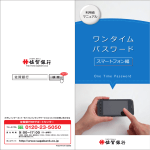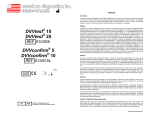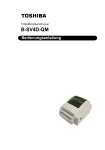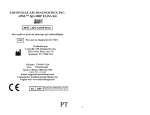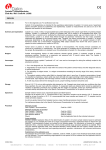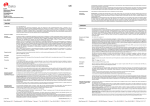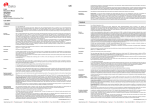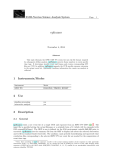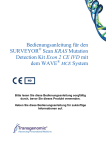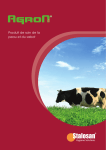Download ACTICLOT Protein C Resistance Control Plasmas
Transcript
Kaplaneigasse 35 • 64319 Pfungstadt • Germany Tel: +49 6151 990899 • Fax: +49 6151 990808 M ENGLISH INTENDED USE AND APPLICATION Control plasmas for confirmation of factor V Leiden mutation (FV:Q506) in assays for determination of the functional phenotype for activated protein C resistance caused by the factor V Leiden mutation. INTRODUCTION ® ACTICLOT Protein C Resistance Control Plasmas REF ADG840C ACTICLOT® Protein C Resistance Controls is a kit containing pooled plasmas from donors genotyped for the factor V Leiden mutation (FV:Q506). Controls contain pooled plasmas of donors with either heterozygous FV:Q506 mutation or normal wild-type pattern. The genetic type of each blood donor has been checked and verified by PCR typing. The controls are intended to be used in combination with ACTICLOT® Protein C Resistance (REF ADG840), a plasma based functional assay for the determination of resistance to activated protein C caused by the factor V Leiden mutation (FV:Q506) [1], or an equivalent APC Resistance test. REAGENTS Controls IVD C i l 8°C 2° Content C1 FV-L Negative Control (human plasma) 3 vials (lyophilized, to be reconstituted in 1.0 ml of deionized water per vial) C2 FV-L Heterozygous Control (human plasma) 3 vials (lyophilized, to be reconstituted in 1.0 ml of deionized water per vial) MATERIALS REQUIRED BUT NOT PROVIDED • • • Deionized water Calibrated pipette (1000 µl) Automated or semi-automated coagulation instruments which employ mechanical or optical detection methods Note: When using automated or semi-automated coagulation analyzers refer always to manufacturer’s operator manual or ask for a detailed adaptation protocol. PREPARATION AND USE OF ACTICLOT® PROTEIN C RESISTANCE CONTROLS Prepare controls in the following way: Reconstitute negative and heterozygous control in 1.0 ml deionized water, incubate in closed vials for 30 min. at room temperature and swirl gently before use. Attention: Extended incubation of controls C1 and C2 may - due to their high protein content - cause a phase separation characterized by a clear solution with a fine whitish layer on its surface. This may be erroneously interpreted as coagulation. Therefore, the controls should absolutely be brought in their initial homogeneous and cloudy form just before use. STORAGE AND STABILITY EC REP american diagnostica GmbH Kaplaneigasse 35, D-64319 Pfungstadt, Germany Tel. + 49 61 57 / 99 08 99 • Fax + 49 61 57 / 99 08 08 The control kit may be used up to the expiry date given on the label when stored unopened at 2-8 °C. Stability of the reagents after reconstitution: Controls C1 C2 Stability - 20°C 15 - 25°C - 20°C 15 - 25°C 6 months 8 hours (on board) 6 months 8 hours (on board) The control plasmas should be thawed at 37°C and gently mixed before use. Freeze only once. 1 CERTIFIED RANGES Zusätzlich benötigte Materialien Different clotting times will be obtained with different types of instruments depending on the clot detection principle. The table (see separate page) shows the individual ranges of ratios for all instruments where a certification of the controls was carried out (KC-4 A™ Micro, BCS®, CA-1500/CA-7000, ACL 9000™, AMAX CS-190™, STA® C). • • • If values outside these ranges are obtained using the controls, the test results are not valid and shall not be used for diagnostic purposes. Hinweis: bei Verwendung automatisierter oder halbautomatisierter Gerinnungsgeräte beachten Sie bitte die Bedienungsanleitung oder fragen Sie für detaillierte Adaptionsprotokolle. When controls are used in combination with another suitable test or instrument, expected ratio values may be different and have to be determined locally under appropriate conditions. VORBEREITUNG UND GEBRAUCH VON ACTICLOT® PROTEIN C RESISTANCE CONTROLS Entionisiertes oder destilliertes Wasser Kalibrierte Pipette (1000 µL) Automatisierte oder halbautomatisierte Gerinnungsgeräte, die mechanische oder optische Nachweismethoden verwenden. Bereiten Sie die Kontrollen wie folgt vor: PRECAUTIONS Each donor unit used in the preparation of the control plasmas has been tested for antibodies against HIV Type 1 and 2, Hepatitis C-Virus antibodies, Treponema pallidum antibodies as well as Hepatitis B surface-antigen and Hepatitis C genome by PCR. The tests used are all CE certified tests according to list A of the European Directive for IVDs (98/79/EC) and are under supervision by the responsible European governmental authority. The plasmas were found to be negative on the tested parameters. However, since no test can completely rule out the presence of blood borne diseases these control plasmas have to be handled as potentially infectious material. Negative und heterozygote Kontrollen werden mit 1.0 ml entionisiertem oder destilliertem Wasser aufgelöst, für 30 Minuten bei Raumtemperatur inkubiert und vor Gebrauch vorsichtig durchmischt. Achtung: Bei den Kontrollen C1 und C2 kann es aufgrund des hohen Proteinanteils bei längeren Inkubationszeiten zu einer Phasentrennung kommen, die durch eine feine, weissliche Schicht an der Oberfläche einer klaren Lösung gekennzeichnet ist. Sie kann irrtümlich als Gerinnung interpretiert werden. Es ist deshalb unbedingt darauf zu achten, dass die Kontrollen vor der Verwendung durch leichtes Durchmischen wieder in die ursprüngliche homogene und leicht trübe Form gebracht werden. LAGERUNG UND STABILITÄT BIBLIOGRAPHY 1. Greengard, J. S., Sun, X., Xu, X., Fernandez, J. A., Griffin, J. H. and Evatt, B. Activated protein C resistance caused by Arg506Gln mutation in factor Va. Lancet 1994, 343: 1361-1362. Der Kontrollkit kann bei Lagerung ungeöffnet bei +2 - +8°C bis zu dem auf dem Etikett angegebenen Ablaufdatum verwendet werden. Stabilität der Kontrollplasmen nach Rekonstitution: Kontrollen C1 C2 DEUTSCH VERWENDUNGSZWECK Kontrollplasmen für die Bestätigung der durch die Faktor V (FV) Leiden Mutation (FV:Q506) bedingten Resistenz von FV gegen aktiviertes Protein C in Methoden für die Bestimmung des funktionellen Phänotyps dieser Resistenz. EINLEITUNG ACTICLOT® Protein C Resistance Controls ist ein Testkit, der gepooltes Plasma von genotypisierten Spendern enthält, die positiv sind für Faktor V Leiden Mutation (FV:Q506). Die Kontrollen enthalten Poolplasma entweder von Spendern mit heterozygoter Mutation oder dem normalen Wildtyp. Der Genotyp jedes Blutspenders wurde mittels PCR geprüft und verifiziert. Die Kontrollen sind bestimmt für den Gebrauch in Verwendung mit ACTICLOT® Protein C Resistance (REF ADG840), einem plasma-basierten funktionellen Test für die Bestimmung der durch die Faktor V Leiden Mutation verursachten Resistenz gegen aktiviertes Protein C, oder mit einem äquivalenten APC Resistenztest. INHALT Kontrollen Inhalt C1 FV-L Negative Control (Humanplasma) 3 Fläschchen (Lyophilisat, aufzulösen mit 1.0 mL entionisiertem Wasser pro Fl.) C2 FV-L Heterozygous Control (Humanplasma) 3 Fläschchen (Lyophilisat, aufzulösen mit 1.0 mL entionisiertem Wasser pro Fl.) 2 Stabilität - 20°C 15 - 25°C - 20°C 15 - 25°C 6 Monate 8 Stunden (im Gerät) 6 Monate 8 Stunden (im Gerät) Die Kontrollplasmen sollten bei 37°C aufgetaut und vor dem Gebrauch schonend gemischt werden. Nur einmal einfrieren. ZERTIFIZIERTE BEREICHE Je nach Detektionsprinzip werden auf verschiedenen Geräten unterschiedliche Gerinnungszeiten gemessen. Die auf separater Seite aufgeführte Tabelle gibt die individuellen Bereiche der Ratios für alle Geräte wieder, an denen eine Zertifizierung der Kontrollen durchgeführt wurde (KC-4 A™ Micro, BCS®, CA-1500/CA-7000, ACL 9000™, AMAX CS-190™, STA® C). Werden mit den Kontrollplasmen Werte ausserhalb der angegebenen Bereiche ermittelt, sind die Testergebnisse dieser Serie ungültig und dürfen nicht für Diagnosezwecke verwendet werden. Werden die Kontrollen zusammen mit anderen geeigneten Tests oder Geräten verwendet, können abweichende Bereiche beobachtet werden. Diese sind unter geeigneten Bedingungen vor Ort zu bestimmen. VORSICHTSMAßNAHMEN Jede Spendeeinheit, die für die Herstellung dieser Reagenzien verwendet wurde, ist auf HIV 1 und 2 Antikörper, Hepatitis C-Virus, Treponema pallidum, ebenso wie Hepatitis B Oberflächenantigen und Hepatitis C-Genom (PCR) getestet und für negativ befunden worden. Trotzdem sollte davon ausgegangen werden, dass bei keinem Test die Anwesenheit von über das Blut übertragenen Erkrankungen absolut auszuschließen ist. Daher sollten Kontrollplasmen generell als potenziell infektiös betrachtet werden. BIBLIOGRAPHIE 1. Greengard, J. S., Sun, X., Xu, X., Fernandez, J. A., Griffin, J. H. and Evatt, B. Activated protein C resistance caused by Arg506Gln mutation in factor Va. Lancet 1994, 343: 1361-1362. 3 FRANÇAIS Utilisation prévue et application Plasmas de contrôle servant à confi rmer la mutation de facteur V Leiden (FV:Q506) dans des tests de détermination du phénotype fonctionnel de la résistance à la protéine C activée provoquée par la mutation du facteur V Leiden. La trousse de contrôle fermée et stockée entre 2 et 8 °C peut être utilisée jusqu’à la date de péremption mentionnée sur l’étiquette. Stabilité des plasmas de contrôle après reconstitution: Contrôles C1 Introduction ACTICLOT® Protein C Resistance Controls constituent une trousse contenant des plasmas provenant de donneurs ayant le génotype de la mutation du facteur V Leiden (FV:Q506). Il s’agit d’un pool de plasmas de donneurs présentant soit une mutation FV:Q506 hétérozygote, soit un schéma «wild-type» normal, le génotype de chaque donneur ayant été contrôlé et vérifié par typage PCR. Les contrôles sont destinés à être utilisés en association avec le ACTICLOT® Protein C Resistance (REF ADG840), un test plasmatique fonctionnel servant à déterminer la résistance à la protéine C activée provoquée par la mutation de facteur V Leiden (FV:Q506) [1] ou un test de résistance à l’APC équivalent. Contenu Contrôles Stockage et stabilité Contenu C1 FV-L Negative Control (plasma humain) 3 flacons (lyophilisat, à reconstituer dans 1.0 ml d’eau déionisée par flacon) C2 FV-L Heterozygous Control (plasma humain) 3 flacons (lyophilisat, à reconstituer dans 1.0 ml d’eau déionisée par flacon) Matériaux requis mais non fournis • Eau déionisée • Pipette graduée (1000 μl) • Instruments de coagulation automatiques ou semi-automatiques employant des méthodes de détection optique ou mécanique. Remarque: En utilisant des instruments de coagulation automatiques ou semi-automatiques, il faut toujours se référer au manuel d’utilisation du fabricant ou demander un protocole d’adaptation détaillé. Préparation et utilisation des ACTICLOT® Protein C Resistance Controls Préparez les contrôles de la manière suivante: Reconstituez les contrôles négatif et hétérozygote dans 1.0 ml d’eau déionisée, incubez dans des flacons fermés pendant 30 min. à température ambiante et agitez délicatement avant utilisation. Attention: En cas d’incubation prolongée, les contrôles C1 et C2 peuvent, en raison de leur forte teneur en protéines, montrer une séparation de phases qui se manifeste par une solution transparente à la surface de laquelle se trouve une fine couche blanchâtre. Cela peut être faussement interprété en tant que coagulation. Pour cette raison il faut absolument les rendre homogènes et opaques par agitation douce juste avant utilisation. C2 Stabilité - 20°C 15 - 25°C - 20°C 15 - 25°C 6 mois 8 heures (on-board) 6 mois 8 heures (on-board) Les plasmas de contrôle doivent être décongelés à 37 °C et agités délicatement avant utilisation. Ne congeler qu‘une fois. Valeurs limites certifi ées Des temps de coagulation différents sont obtenus selon les différents types d’instruments et le principe de détection du thrombus. Les valeurs limites mentionnées dans le tableau (page séparée) indiquent les limites individuelles des rapports pour tous les instruments, pour lesquelles une certification des contrôles a été exécutée (KC-4 A™ Micro, BCS®, CA-1500/CA-7000, ACL 9000™, AMAX CS-190™, STA® C). Si l’on obtient des valeurs en dehors de ces limites, les résultats de cette série de tests ne sont pas valables et ne doivent pas être utilisés à des fins diagnostiques. Si les contrôles sont utilisés en association avec d’autres tests ou instruments adéquats, les valeurs attendues peuvent être différentes et doivent être déterminées localement dans les conditions appropriées. Précautions Chaque unité de donneur utilisée pour la préparation des plasmas de contrôle a été testée quant à la présence d’anticorps contre le HIV 1 et 2, d’anticorps contre le virus de l’hépatite C, d’anticorps contre le tréponème pâle ainsi que de l’antigène de surface de l’hépatite B et le génome de l’hépatite C et HIV 1 (PCR), le résultat du test devant être négatif. Les tests utilisés à cet effet sont des tests certifiés CE selon la liste A des Directives IVD Européennes (98/79/CE) et sont soumises au contrôle des autorités responsables. Toutefois, comme aucun test ne peut exclure totalement la présence de maladies transmissibles par le sang, ces contrôles doivent être considéré comme potentiellement infectieux et manipulé en conséquence. Bibliographie 1. Greengard, J. S., Sun, X., Xu, X., Fernandez, J. A., Griffin, J. H. and Evatt, B. Activated protein C resistance caused by Arg506Gln mutation in factor Va. Lancet 1994, 343: 1361-1362. ADG840C©ADGmbH03.2009_840C_packageinsert_V9 4 5



